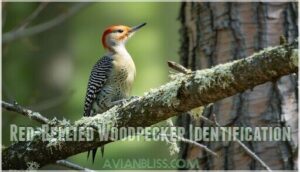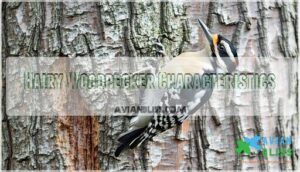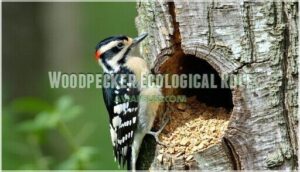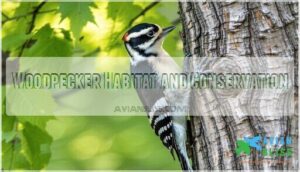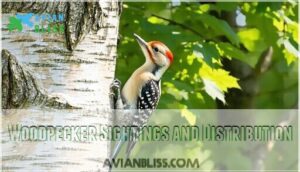This site is supported by our readers. We may earn a commission, at no cost to you, if you purchase through links.

These fascinating birds include year-round residents like the Red-bellied and Hairy Woodpeckers, plus seasonal visitors such as the Yellow-bellied Sapsucker.
Each species has developed unique adaptations – from the Downy’s ability to hang upside-down on thin branches to the Pileated’s powerful bill that can excavate rectangular holes in dead trees.
Minnesota’s diverse forests, from northern conifers to southern hardwoods, provide perfect habitat for this remarkable variety of woodpeckers, each with distinct markings and behaviors that make identification an exciting challenge.
Table Of Contents
- Key Takeaways
- Minnesota Woodpecker Species
- Woodpecker Physical Characteristics
- Woodpecker Behavior and Diet
- Woodpecker Habitat and Conservation
- Woodpecker Sightings and Distribution
- Frequently Asked Questions (FAQs)
- What is the most common woodpecker in Minnesota?
- What bird looks like a woodpecker but isn’t?
- What is the difference between a ladderback woodpecker and a red-bellied woodpecker?
- Can you shoot a Pileated Woodpecker?
- Can you shoot pileated woodpeckers in MN?
- How rare is it to see a Pileated Woodpecker?
- How can woodpeckers be attracted to yards?
- Do woodpeckers damage trees and property?
- What predators pose threats to woodpeckers?
- Are any woodpecker species endangered in Minnesota?
- Conclusion
Key Takeaways
- You’ll find 11 woodpecker species across Minnesota, ranging from the tiny 6-inch Downy Woodpecker to the massive crow-sized Pileated Woodpecker that creates rectangular holes in dead trees.
- You can easily attract common species like Downy, Hairy, and Red-bellied Woodpeckers to your yard year-round by providing suet feeders, fresh water, and leaving dead trees standing for nesting sites.
- You’ll need to visit northern Minnesota’s boreal forests to spot the state’s rarest woodpeckers – Black-backed and American Three-toed Woodpeckers – which specialize in post-fire habitats and mature coniferous stands.
- You should know that Red-headed Woodpeckers face severe conservation challenges with a 95% population decline since the 1960s, making them Minnesota’s most threatened woodpecker species due to habitat loss and dead tree removal.
Minnesota Woodpecker Species
You’ll find eleven woodpecker species calling Minnesota home, ranging from the tiny Downy Woodpecker to the impressive crow-sized Pileated Woodpecker.
Minnesota’s woodpecker diversity spans from tiny backyard visitors to impressive forest giants.
These remarkable birds include common feeder visitors like the Red-bellied and Hairy Woodpeckers, along with rare northern specialists such as the Black-backed and American Three-toed Woodpeckers.
Common Woodpecker Species
When you’re exploring Minnesota woodpeckers, you’ll encounter three feeder favorites that dominate suburban woodpeckers across the state.
These backyard habitats support year-round residents with diverse common diets:
- Downy Woodpecker – Minnesota’s smallest species at under 7 inches, found in all 87 counties with stable populations since 1970
- Hairy Woodpecker – Larger cousin measuring 7-10 inches, distinguished by its longer, chisel-like bill and year-round presence
- Red-bellied Woodpecker – Medium-sized at 9.4 inches, expanding northward with distinctive zebra-striped backs
These common woodpeckers represent your best bet for successful woodpecker identification in Minnesota.
These species are protected by law.
Less Common Woodpecker Species
While these Minnesota woodpeckers aren’t daily backyard visitors, they’re worth seeking out.
The majestic Pileated Woodpecker, with its crow-sized frame and flaming red crest, inhabits mature forests where Pileated Behavior includes excavating large rectangular holes.
Northern Flickers spend considerable time ground-foraging, making their Flicker Diet unique among woodpeckers.
Yellow-bellied Sapsuckers prefer mixed woodlands for their Sapsucker Habitat, drilling neat rows of holes to collect tree sap.
The Hairy Woodpecker, a common resident, has a continental concern score of 6/20, which is a notable conservation status.
Rare Woodpecker Species
You’ll discover three rare woodpecker species in Minnesota’s boreal habitats, where fire ecology shapes their survival.
These specialists face significant population threats from habitat loss and fire suppression practices.
Minnesota’s rarest woodpecker species include:
- Black-backed Woodpecker – Thrives in post-fire coniferous forests, targeting wood-boring beetle larvae
- American Three-toed Woodpecker – Inhabits mature boreal stands with abundant deadwood
- Red-headed Woodpecker – Experienced 95% population decline since the 1960s
- Conservation strategies focus on habitat restoration and post-fire forest management
- Sighting locations concentrate in northern Minnesota’s remote wilderness areas
These woodpecker species require specialized conservation approaches and dedicated Minnesota birdwatching efforts.
Woodpecker Species Distribution
Woodpecker distribution across Minnesota reflects each species’ habitat needs and environmental pressures.
You’ll find distinct patterns shaped by forest management practices, climate change effects, and urban expansion impacts.
| Species | Primary Region | Habitat Preference | Population Trend | Conservation Status |
|---|---|---|---|---|
| Downy Woodpecker | Statewide (all 87 counties) | Oak woodlands, urban areas | Stable | Secure |
| Red-headed Woodpecker | Southern/Central Minnesota | Open woodlands, savannas | Declining 95% since 1967 | Concern |
| Black-backed Woodpecker | Northern boreal forests | Coniferous forests | Stable in range | Specialized |
| Red-bellied Woodpecker | Southeast/Central regions | Deciduous forests | Expanding northward | Increasing |
| American Three-toed | Remote northern forests | Boreal conifers | Rare (5 county records) | Specialized |
Habitat fragmentation and prey availability directly influence where you’ll spot these woodpecker species during Minnesota birdwatching adventures, making understanding their distribution essential for successful observation.
The woodpecker species are impacted by various factors, and recognizing these elements is crucial for their conservation status and population trend.
Woodpecker Physical Characteristics
You’ll find that identifying Minnesota’s woodpeckers becomes much easier once you know their key physical features.
Each species has distinctive characteristics that set them apart, from the crow-sized pileated woodpecker’s bright red crest to the tiny downy woodpecker’s spotted wings.
Pileated Woodpecker Features
Spotting a Pileated Woodpecker feels like encountering a feathered giant. This crow-sized species dominates Minnesota’s woodpecker identification scene with its striking red crest and dramatic black plumage.
Males display a distinctive red mustache stripe, while females show black facial markings. Their powerful drumming sound echoes through mature forests, where these impressive birds create rectangular holes in dead trees.
Their size comparison to other woodpecker species makes identification straightforward for Minnesota birdwatchers, with the Pileated Woodpecker being a notable example of a crow-sized species and having a striking red crest.
Downy Woodpecker Details
The smallest woodpecker in Minnesota measures under seven inches, making it a true featherweight champion among its percussion-loving relatives.
You’ll recognize this compact species by its distinctive black and white plumage variations and proportionally small bill morphology, perfectly adapted for precise foraging in Minnesota’s diverse woodpecker habitat.
- Downy size – At just 5.5 to 6.7 inches long, it’s Minnesota’s tiniest drummer
- White breast and back – Clean plumage contrasts sharply with black wings
- Spotted wing pattern – White spots create distinctive identification markers
- Sexual dimorphism – Males sport red crown patches while females don’t
- Compact bill – Short, chisel-like beak suits their specialized woodpecker diet
Red-Bellied Woodpecker Identification
Don’t let the name fool you—the redbellied woodpecker’s most striking feature isn’t its faint pinkish belly coloration, but rather its brilliant red head stripe extending from beak to nape.
This medium-sized Minnesota bird displays distinctive zebra back patterns with black-and-white barring.
Males and females show minimal sex differences, both sporting the characteristic red crown. At 9.4 inches long, size comparison places it between the tiny downy and massive pileated woodpecker, making woodpecker identification straightforward for Minnesota birds enthusiasts using bird identification guides.
Hairy Woodpecker Characteristics
You’ll recognize the Hairy Woodpecker by its striking black and white plumage details and distinctive bill morphology.
This Minnesota woodpecker species measures 7-10 inches, making size comparison with the smaller Downy straightforward.
Its long, chisel-like bill distinguishes it from other woodpecker species, while sharp vocalizations help with woodpecker identification.
They also have plain outer tail feathers, unlike Downy Woodpeckers.
These distinguishing features make Hairy Woodpecker characteristics unmistakable in Minnesota’s forests.
Woodpecker Behavior and Diet
You’ll discover that Minnesota’s woodpeckers exhibit fascinating behaviors and dietary preferences that vary substantially between species.
From the Downy Woodpecker’s acrobatic foraging techniques to the Red-bellied Woodpecker’s opportunistic feeding habits, each species has evolved unique strategies to thrive in Minnesota’s diverse ecosystems.
Woodpecker Drumming Calls
Woodpecker drumming calls signal spring’s arrival in mid-to-late winter, serving multiple communication purposes beyond simple noise-making.
These rhythmic percussion sounds help establish territory boundaries and attract potential mates across Minnesota’s diverse forest landscapes.
Birds also use non-vocal communication techniques to convey messages.
- Drumming Purpose: Territory establishment and mate attraction drive most drumming behavior
- Drumming Frequency: Rapid-fire beats create species-specific patterns for identification
- Species Variation: Each woodpecker species produces distinct drumming rhythms and intensities
- Drumming Acoustics: Hollow trees amplify sounds, maximizing communication range effectiveness
Downy Woodpecker Foraging
You’ll notice Downy Woodpeckers clinging to tree trunks and branches during winter foraging expeditions.
These agile birds excel at bark probing techniques, using their small bills to extract beetle larvae and other insects from crevices.
Their suet preference makes them frequent backyard visitors, where insect consumption supplements their natural diet effectively.
| Foraging Location | Primary Food Source | Seasonal Behavior |
|---|---|---|
| Tree bark crevices | Beetle larvae, ants | Year-round probing |
| Suet feeders | High-fat suet cakes | Winter preference |
| Dead wood snags | Wood-boring insects | Intensive excavation |
| Weed stalks | Insect eggs, larvae | Late fall activity |
| Branch tips | Caterpillars, aphids | Spring/summer feeding |
The provided table outlines the various foraging locations and corresponding primary food sources for Downy Woodpeckers, along with their seasonal behavior.
Red-Bellied Woodpecker Diet
After watching Downy Woodpeckers hunt insects, you’ll spot the Red-Bellied Woodpecker using clever foraging techniques to meet its nutritional needs.
This Minnesota bird species enjoys a varied woodpecker diet—seasonal food sources like nuts, fruit, insects, and even sap.
At feeders, it shows clear feeder preferences for suet and seeds, reflecting smart dietary adaptations for Minnesota’s changing seasons.
Woodpecker Ecological Role
Beyond their striking appearance, woodpeckers serve as ecosystem engineers in Minnesota’s forests.
These species function as natural pest control agents, consuming massive quantities of beetle larvae, ants, and termites that threaten forest health.
Through seed dispersal and habitat creation via their excavated cavities, woodpeckers support biodiversity while maintaining ecological balance across Minnesota’s diverse woodpecker habitats.
Woodpecker Habitat and Conservation
You’ll find woodpeckers thriving in Minnesota’s diverse habitats, from oak woodlands to suburban backyards.
Though several species face serious conservation challenges due to habitat loss and human interference.
Understanding their habitat needs and current conservation status helps you support these remarkable birds through yard improvements and habitat protection efforts.
Woodpecker Habitat Preferences
Different woodpecker species across Minnesota show distinct habitat preferences based on forest type, nesting sites, and food availability.
You’ll find these patterns shape where each species thrives in our state’s diverse landscapes.
Here are four key habitat preferences for Minnesota’s woodpeckers:
- Oak Woodlands – Downy Woodpeckers show the strongest affinity for oak forests, which provide abundant insect prey and suitable nesting cavities
- Mature Deciduous Forests – Pileated Woodpeckers require large, established hardwood and mixed forests with plenty of dead trees for excavating nest holes
- Suburban Areas – Red-bellied Woodpeckers adapt well to urban habitats with mature trees, parks, and residential neighborhoods offering diverse food sources
- Boreal Habitats – Black-backed and American Three-toed Woodpeckers prefer northern coniferous forests, especially areas recovering from natural disturbances like fires.
Creating artificial nesting sites can further support woodpecker populations in these varied environments.
Conservation Status and Trends
Conservation challenges threaten Minnesota’s woodpecker populations, with habitat loss and climate change driving significant declines.
Minnesota’s woodpeckers are facing a quiet crisis as forests disappear and climate shifts.
Red-headed Woodpeckers face the steepest drops, declining 95% over 50 years due to oak savanna conversion and dead tree removal.
Fire suppression impacts boreal species, while conservation actions target habitat restoration and protection efforts.
| Species | Population Trend | Conservation Status | Primary Threats |
|---|
The conservation status of these species varies, with some, like the Red-headed Woodpecker, being of Greatest Conservation Need, while others, such as the Downy Woodpecker, are considered Stable or of Least Concern.
Attracting Woodpeckers to Your Yard
Creating an inviting woodpecker habitat in your yard requires strategic planning and the right resources.
You’ll transform your outdoor space into a haven that attracts these fascinating birds year-round.
Essential elements for attracting woodpeckers include:
- Suet feeders filled with high-energy fat mixtures that provide vital nutrition during harsh Minnesota winters
- Native trees like oak and maple that offer natural foraging opportunities and support local insect populations
- Bird baths with fresh water sources for drinking and bathing, especially important during dry spells
- Dead trees or snags left standing to provide nesting sites and abundant insect prey for woodpecker families
Consider exploring options for specialized suet products to cater to woodpeckers.
Woodpecker Conservation Efforts
Minnesota’s woodpecker conservation efforts focus on habitat preservation and addressing population decline through targeted strategies.
Fire suppression policies negatively impact black-backed and American three-toed woodpeckers, while red-headed woodpeckers face severe habitat loss.
Community involvement and backyard conservation initiatives help support these important bird species.
| Conservation Strategy | Target Species |
|---|---|
| Habitat Preservation | All woodpecker species |
| Fire Management | Black-backed, Three-toed |
| Dead Tree Retention | Red-headed, Pileated |
| Backyard Conservation | Downy, Red-bellied |
Woodpecker Sightings and Distribution
If you’re wondering where to spot Minnesota’s woodpeckers, you’ll find different species distributed across various habitats throughout the state.
From year-round residents like the Red-bellied and Hairy Woodpeckers that you can observe in any season, to the specialized northern species that require specific forest conditions for breeding and nesting success, which includes the Hairy Woodpeckers.
Year-Round Woodpecker Residents
Most Minnesota woodpecker species stick around through winter, showing impressive Winter Survival skills.
You’ll find nine species that don’t migrate, including downy, hairy, and red-bellied woodpeckers maintaining their Territory Defense year-round.
These overwintering birds adapt their Feeding Habits to survive harsh conditions, ensuring Population Stability.
Their Breeding Success depends on established territories, making woodpecker identification easier since Minnesota wildlife enthusiasts can observe consistent woodpecker species throughout all seasons.
Migratory Woodpecker Species
You’ll notice that woodpecker migration in Minnesota is limited, but the Yellow-bellied Sapsucker stands out as a true traveler.
Its migration routes stretch between northern breeding grounds and southern winter habitats, triggered by changes in daylight and temperature.
Climate change now impacts bird migration patterns, sometimes shifting these woodpecker species’ schedules and destinations, making each spring arrival a bit unpredictable due to changes in daylight.
Regional Woodpecker Distribution
Understanding woodpecker range across Minnesota reveals fascinating patterns driven by habitat variation and climate impact.
You’ll find species density varies dramatically from north to south, with forest fragmentation affecting woodpecker sightings throughout the state.
- Southern regions support higher red-headed and red-bellied woodpecker populations in oak savannas
- Northern boreal forests harbor rare black-backed and American three-toed species exclusively
- Pileated Woodpecker populations concentrate in central/northern mature forest tracts for Minnesota bird identification.
South Carolina, by contrast, is home to eight woodpecker species.
Woodpecker Breeding and Nesting Habits
You’ll find woodpecker nesting habits fascinating across Minnesota’s diverse landscapes.
Most species excavate fresh nesting cavities each spring, with clutch size variation ranging from three to eight eggs depending on the species.
Parental care duration extends four to six weeks, though fledgling survival rates face challenges from nesting habitat loss.
Red-bellied and pileated woodpeckers show remarkable adaptability in their woodpecker breeding strategies throughout Minnesota’s changing forests.
Frequently Asked Questions (FAQs)
What is the most common woodpecker in Minnesota?
You’ll spot downy woodpeckers everywhere, from backyard feeders to forest trails. These tiny, black-and-white birds with red-crowned males are Minnesota’s most common woodpecker species, thriving year-round.
What bird looks like a woodpecker but isn’t?
The White-breasted Nuthatch often gets mistaken for a woodpecker.
You’ll see it creeping headfirst down tree trunks, but it’s actually searching for insects in bark crevices, not drilling holes like true woodpeckers do.
What is the difference between a ladderback woodpecker and a red-bellied woodpecker?
Like zebras in a forest, ladderback and red-bellied woodpeckers display distinct patterns.
You’ll notice ladderbacks have horizontal black-and-white stripes across their backs, while red-bellied woodpeckers sport vertical zebra-like barring with distinctive red crowns and faint pinkish bellies.
Can you shoot a Pileated Woodpecker?
You legally can’t shoot Pileated Woodpeckers in Minnesota. They’re protected under the Migratory Bird Treaty Act, making it illegal to hunt, kill, capture, or harass them without proper federal permits.
Can you shoot pileated woodpeckers in MN?
Like crossing a legal minefield, you can’t shoot pileated woodpeckers in Minnesota. They’re protected under federal law and killing them without a permit is illegal.
How rare is it to see a Pileated Woodpecker?
Pileated woodpeckers aren’t extremely rare, but you won’t see them daily. They’re uncommon residents requiring large forest areas with mature trees, making sightings special treats for dedicated birdwatchers.
How can woodpeckers be attracted to yards?
Picture watching a Pileated Woodpecker discover your backyard suet feeder for the first time.
You’ll attract woodpeckers by setting up suet feeders, providing bird baths, and planting native trees that offer natural food sources and nesting sites, which can be considered a complete method to support these birds.
Do woodpeckers damage trees and property?
Woodpeckers can damage trees and property through their natural drilling behavior.
They’ll create holes in siding, gutters, and wooden structures while foraging for insects or establishing territories.
Though most tree damage occurs naturally.
What predators pose threats to woodpeckers?
Like silent shadows stalking through the forest, numerous predators threaten woodpeckers throughout their lives.
Hawks, owls, snakes, raccoons, and squirrels hunt eggs, nestlings, and adults.
Domestic cats also pose significant risks to these birds in residential areas, acting like silent shadows.
Are any woodpecker species endangered in Minnesota?
No woodpecker species are officially endangered in Minnesota.
However, Red-headed Woodpeckers face severe population declines with a 67% range-wide drop since 1970, making them a conservation concern despite their global "Least Concern" status.
Conclusion
Remarkably, woodpeckers possess tongues that can extend up to four inches beyond their bill tips, allowing them to extract insects from deep tree crevices.
You’ve now explored Minnesota’s impressive diversity of woodpeckers, from tiny Downys to massive Pileateds.
Each species fills a unique ecological niche in the state’s forests, whether they’re year-round residents or seasonal visitors.
By understanding their distinct markings, behaviors, and habitat preferences, you’ll confidently identify these remarkable woodpeckers of Minnesota during your next outdoor adventure.
- https://avibirds.com/woodpeckers-of-minnesota/
- https://files.dnr.state.mn.us/assistance/backyard/livingwith_wildlife/woodpecker-control.pdf
- https://mnbirdatlas.org/species/red-headed-woodpecker/
- https://wildbirdstore.com/2020/10/12/five-common-mn-woodpeckers/
- https://avianreport.com/woodpeckers-central-region/



